2018 HONDA CLARITY PLUG IN HYBRID brake
[x] Cancel search: brakePage 2 of 591
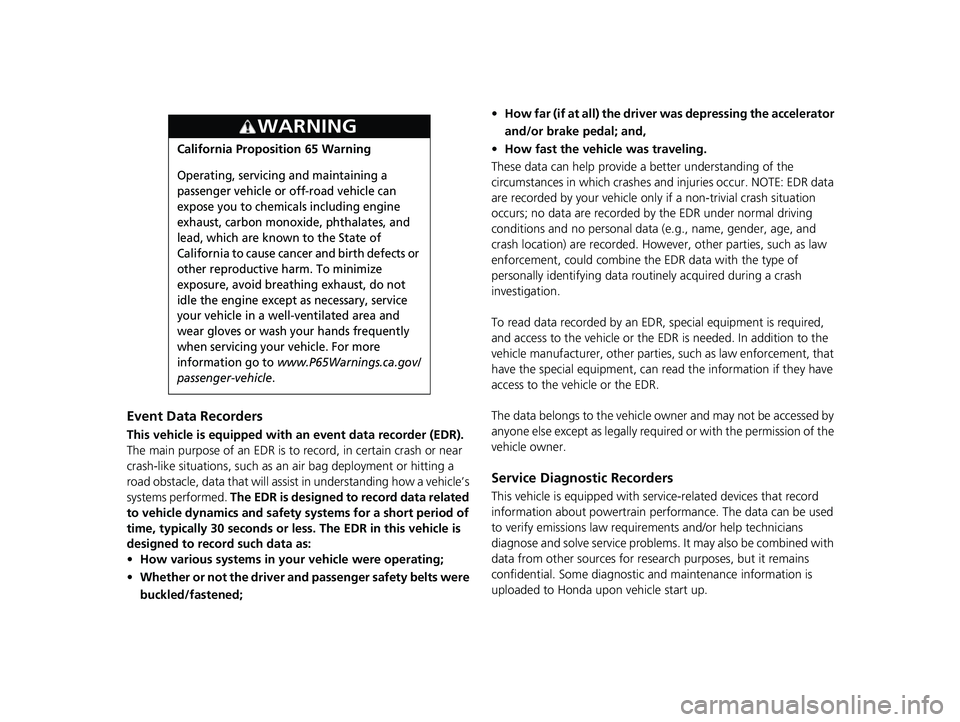
Event Data Recorders This vehicle is equipped with an event data recorder (EDR).
The main purpose of an EDR is to record, in certain crash or near
crash-like situations, such as an air bag deployment or hitting a
road obstacle, data that will assist in understanding how a vehicle’s
systems performed. The EDR is designed to record data related
to vehicle dynamics and safety systems for a short period of
time, typically 30 seconds or le ss. The EDR in this vehicle is
designed to record such data as:
• How various systems in your vehicle were operating;
• Whether or not the driver and passenger safety belts were
buckled/fastened; 3
WARNING California Proposition 65 Warning
Operating, servicing and maintaining a
passenger vehicle or off-road vehicle can
expose you to chemicals including engine
exhaust, carbon monoxide, phthalates, and
lead, which are known to the State of
California to cause cancer and birth defects or
other reproductive harm. To minimize
exposure, avoid breathing exhaust, do not
idle the engine except as necessary, service
your vehicle in a well-ventilated area and
wear gloves or wash your hands frequently
when servicing your vehicle. For more
information go to
www.P65Warnings.ca.gov/
passenger-vehicle . • How far (if at all) the driver was depressing the accelerator
and/or brake pedal; and,
• How fast the vehicle was traveling.
These data can help provide a better understanding of the
circumstances in which crashes and injuries occur. NOTE: EDR data
are recorded by your vehicle only if a non-trivial crash situation
occurs; no data are recorded by the EDR under normal driving
conditions and no personal data (e.g., name, gender, age, and
crash location) are recorded. Howeve r, other parties, such as law
enforcement, could co mbine the EDR data with the type of
personally identifying data rout inely acquired during a crash
investigation.
To read data recorded by an ED R, special equipment is required,
and access to the vehicle or the EDR is needed. In addition to the
vehicle manufacturer, other parties, such as law enforcement, that
have the special equipment, can re ad the informatio n if they have
access to the vehicle or the EDR.
The data belongs to the vehicle ow ner and may not be accessed by
anyone else except as legally requir ed or with the permission of the
vehicle owner.
Service Diagnostic Recorders This vehicle is equipped with se rvice-related devices that record
information about powertrain perfo rmance. The data can be used
to verify emissions law requirem ents and/or help technicians
diagnose and solve service problems. It may also be combined with
data from other sources for res earch purposes, but it remains
confidential. Some diagnostic and maintenance information is
uploaded to Honda upon vehicle start up.18 CLARITY PHEV CSS-31TRW6000.book 0 ページ 2017年8月31日 木曜日 午後2時4 9分
Page 10 of 591
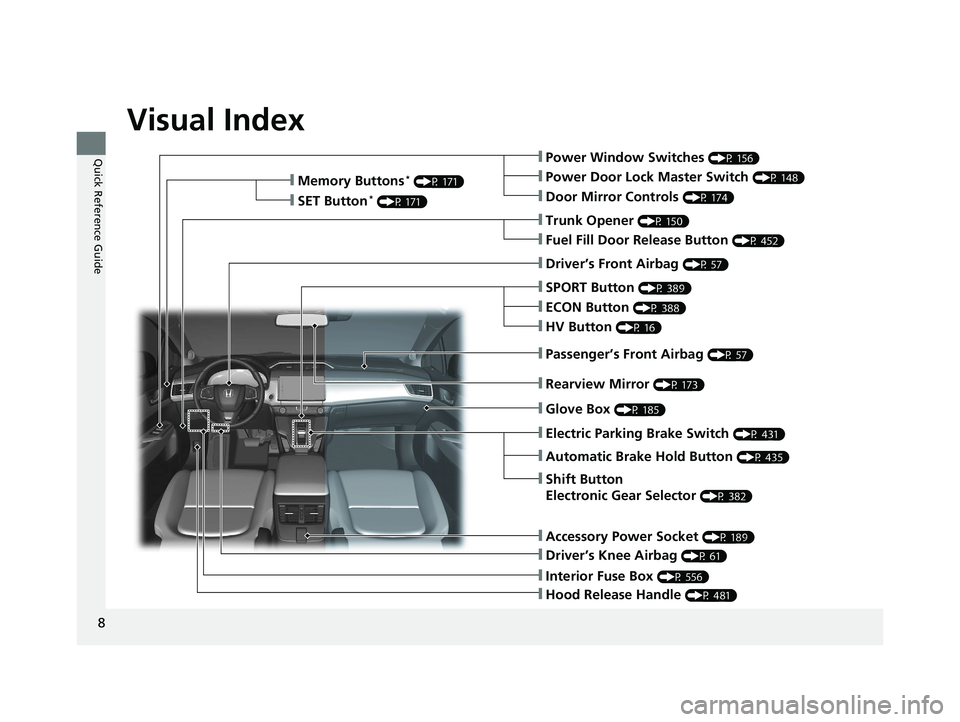
Visual Index
8
Quick Reference Guide ❙ Power Window Switches (P 156)
❙ Trunk Opener (P 150)
❙ Driver’s Knee Airbag (P 61)❙ Door Mirror Controls (P 174)
❙ Power Door Lock Master Switch (P 148)
❙ Fuel Fill Door Release Button (P 452)
❙ Memory Buttons *
(P 171)
❙ SET Button *
(P 171)
❙ Interior Fuse Box (P 556)❙ Automatic Brake Hold Button (P 435)❙ Driver’s Front Airbag (P 57)
❙ Passenger’s Front Airbag (P 57)
❙ SPORT Button (P 389)
❙ Glove Box (P 185)
❙ Electric Parking Brake Switch (P 431)
❙ Shift Button
Electronic Gear Selector (P 382)
❙ Accessory Power Socket (P 189)
❙ Hood Release Handle (P 481)❙ ECON Button (P 388)
❙ HV Button (P 16)
❙ Rearview Mirror (P 173)18 CLARITY PHEV CSS-31TRW6000.book 8 ページ 2017年8月31日 木曜日 午後2時4 9分
Page 12 of 591
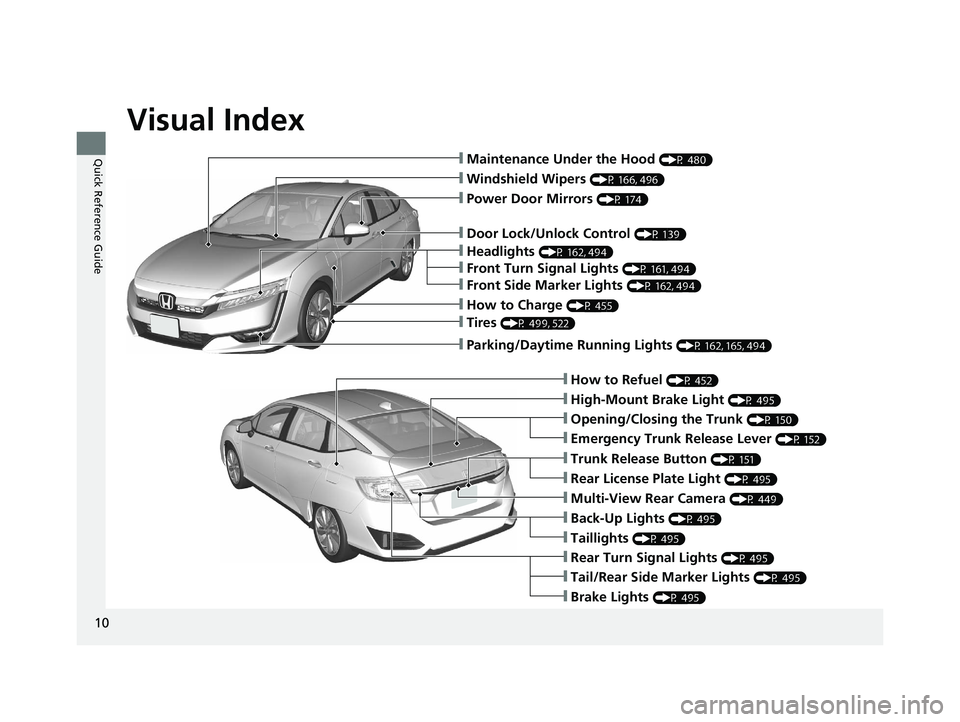
Visual Index
10
Quick Reference Guide ❙ Maintenance Under the Hood (P 480)
❙ Windshield Wipers (P 166, 496)
❙ Tires (P 499, 522)
❙ Door Lock/Unlock Control (P 139)
❙ Power Door Mirrors (P 174)
❙ Headlights (P 162, 494)
❙ Front Turn Signal Lights (P 161, 494)
❙ How to Refuel (P 452)
❙ High-Mount Brake Light (P 495)
❙ Emergency Trunk Release Lever (P 152)
❙ Opening/Closing the Trunk (P 150)
❙ Tail/Rear Side Marker Lights (P 495)
❙ Brake Lights (P 495)
❙ Rear Turn Signal Lights (P 495)
❙ Back-Up Lights (P 495)
❙ Taillights (P 495)
❙ Trunk Release Button (P 151)
❙ Rear License Plate Light (P 495)
❙ Multi-View Rear Camera (P 449)❙ Parking/Daytime Running Lights (P 162, 165, 494)
❙ Front Side Marker Lights (P 162, 494)
❙ How to Charge (P 455)18 CLARITY PHEV CSS-31TRW6000.book 10 ページ 2017年8月31日 木曜日 午後2時 49分
Page 17 of 591
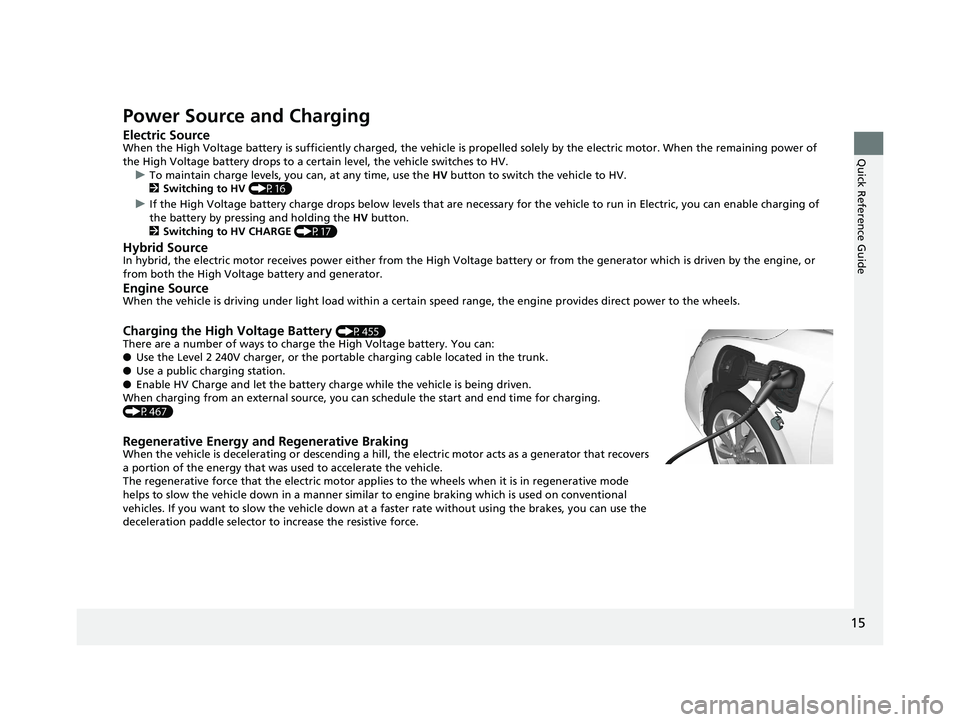
15
Quick Reference Guide
Power Source and Charging Electric Source When the High Voltage battery is sufficiently charged, the vehicl e is propelled solely by the electric motor. When the remainin g power of
the High Voltage battery drops to a certain level, the vehicle switches to HV.
u To maintain charge levels, you can, at any time, use the HV button to switch the vehicle to HV.
2 Switching to HV (P16)
u If the High Voltage battery charge drops below levels that are necessary for the vehicle to run in Electric, you can enable cha rging of
the battery by pressing and holding the HV button.
2 Switching to HV CHARGE (P17)
Hybrid Source In hybrid, the electric motor receives powe r either from the High Voltage battery or from the generator which is driven by the engine, or
from both the High Volt age battery and generator.
Engine Source When the vehicle is driving under light load within a certain speed range, the engine provides direct power to the wheels.
Charging the High Voltage Battery (P455)
There are a number of ways to charge the High Voltage battery. You can:
● Use the Level 2 240V charger, or the portable charging cable located in the trunk.
● Use a public charging station.
● Enable HV Charge and let the battery charge while the vehicle is being driven.
When charging from an external source, you ca n schedule the start and end time for charging.
(P467)
Regenerative Energy and Regenerative Braking When the vehicle is decelerating or descending a hill, the electric motor acts as a generator that recovers
a portion of the energy that was used to accelerate the vehicle.
The regenerative force that the electric motor applie s to the wheels when it is in regenerative mode
helps to slow the vehicle down in a manner similar to engine braking which is used on conventional
vehicles. If you want to slow the vehicle down at a faster rate without using the brakes, you can use the
deceleration paddle selector to increase the resistive force. 18 CLARITY PHEV CSS-31TRW6000.book 15 ページ 2017年8月31日 木曜日 午後2時 49分
Page 25 of 591
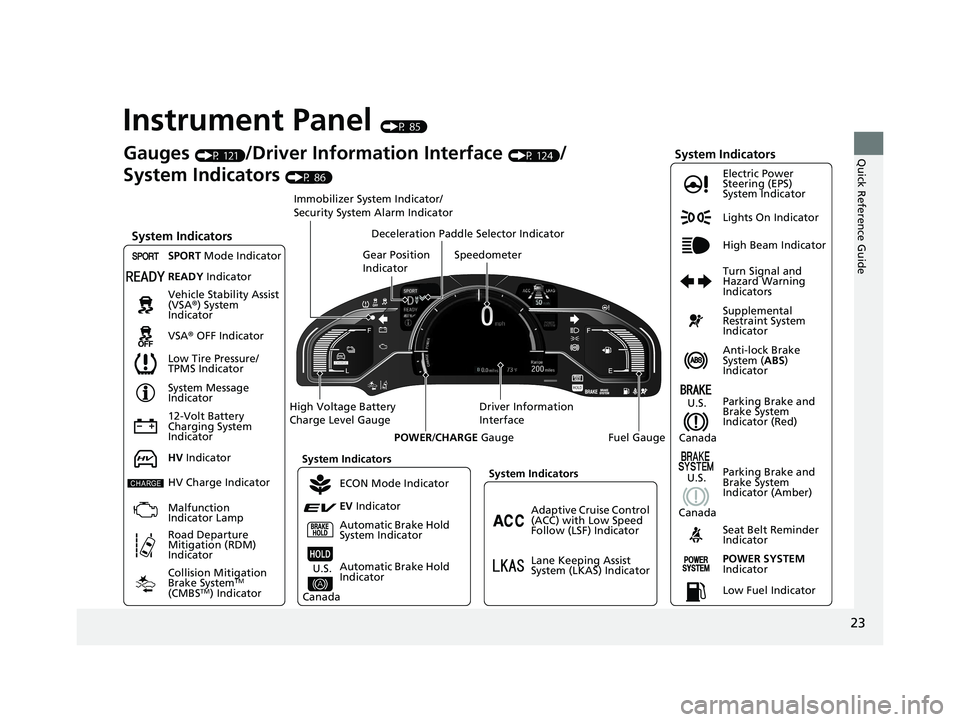
23
Quick Reference Guide
Instrument Panel (P 85)
Lights On Indicator
System Indicators
12-Volt Battery
Charging System
Indicator Anti-lock Brake
System ( ABS )
IndicatorVehicle Stability Assist
(VSA ® ) System
Indicator
VSA ® OFF Indicator Electric Power
Steering (EPS)
System Indicator
System Indicators High Beam Indicator
Seat Belt Reminder
IndicatorSystem Indicators
System Message
Indicator
Parking Brake and
Brake System
Indicator (Red)Supplemental
Restraint System
Indicator
Gauges (P 121)
/Driver Information Interface (P 124)
/
System Indicators (P 86)
Low Tire Pressure/
TPMS Indicator Turn Signal and
Hazard Warning
IndicatorsSpeedometer
Automatic Brake Hold
System Indicator Parking Brake and
Brake System
Indicator (Amber)SPORT Mode Indicator
Collision Mitigation
Brake System TM
(CMBS TM
) IndicatorRoad Departure
Mitigation (RDM)
Indicator Immobilizer System Indicator/
Security System Alarm Indicator
Automatic Brake Hold
IndicatorREADY Indicator
POWER SYSTEM
IndicatorGear Position
Indicator
Fuel GaugeDriver Information
InterfaceHigh Voltage Battery
Charge Level Gauge
POWER / CHARGE Gauge
Low Fuel IndicatorAdaptive Cruise Control
(ACC) with Low Speed
Follow (LSF) Indicator
Lane Keeping Assist
System (LKAS) IndicatorDeceleration Paddle Selector Indicator
System Indicators
ECON Mode Indicator
EV Indicator
U.S.
CanadaHV Indicator
HV Charge Indicator
Malfunction
Indicator Lamp U.S.
Canada U.S.
Canada18 CLARITY PHEV CSS-31TRW6000.book 23 ページ 2017年8月31日 木曜日 午後2時 49分
Page 33 of 591
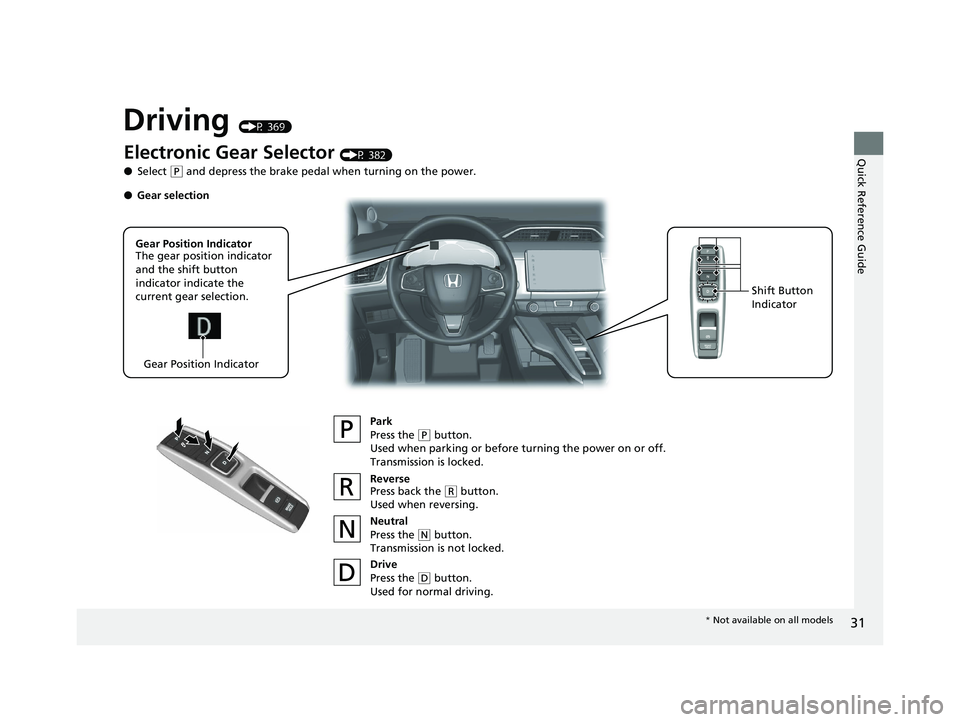
31
Quick Reference Guide
Driving (P 369)
Electronic Gear Selector (P 382)
● Select ( P
and depress the brake pedal when turning on the power.
Park
Press the ( P
button.
Used when parking or before turning the power on or off.
Transmission is locked.
Reverse
Press back the ( R
button.
Used when reversing.
Neutral
Press the ( N
button.
Transmission is not locked.
Drive
Press the ( D
button.
Used for normal driving.Gear Position Indicator
The gear position indicator
and the shift button
indicator indicate the
current gear selection.
Gear Position Indicator Shift Button
Indicator● Gear selection
* Not available on all models18 CLARITY PHEV CSS-31TRW6000.book 31 ページ 2017年8月31日 木曜日 午後2時 49分
Page 36 of 591
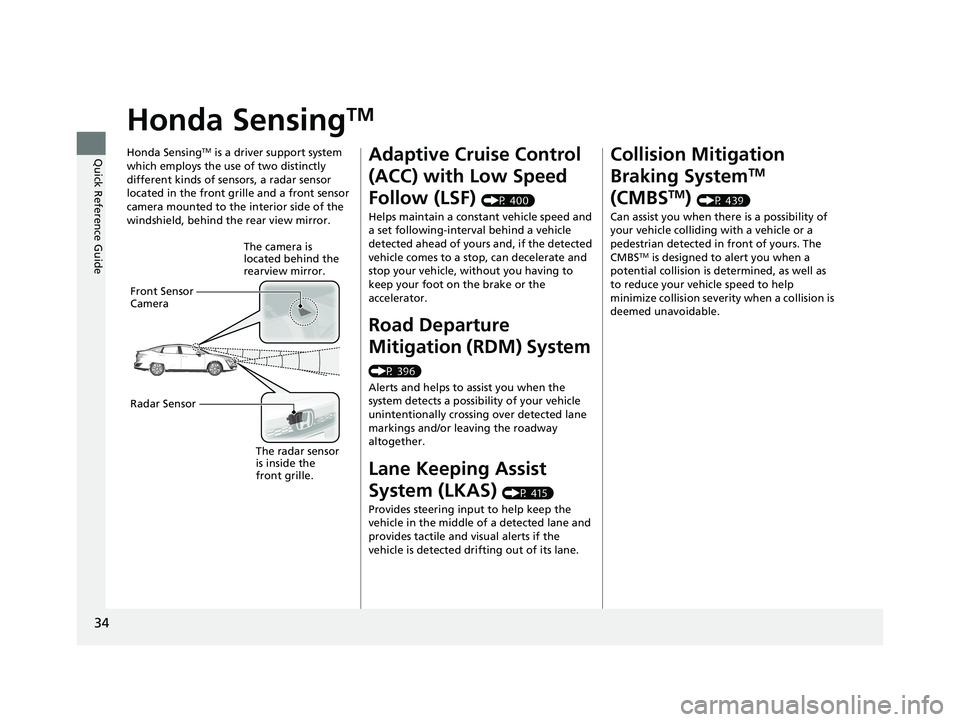
34
Quick Reference Guide Honda Sensing TMHonda Sensing TM
is a driver support system
which employs the use of two distinctly
different kinds of sensors, a radar sensor
located in the front grille and a front sensor
camera mounted to the interior side of the
windshield, behind the rear view mirror.
The camera is
located behind the
rearview mirror.
Front Sensor
Camera
Radar Sensor
The radar sensor
is inside the
front grille.Adaptive Cruise Control
(ACC) with Low Speed
Follow (LSF) (P 400)
Helps maintain a constant vehicle speed and
a set following-interval behind a vehicle
detected ahead of yours and, if the detected
vehicle comes to a stop, can decelerate and
stop your vehicle, wi thout you having to
keep your foot on the brake or the
accelerator.
Road Departure
Mitigation (RDM) System (P 396)
Alerts and helps to assist you when the
system detects a possibility of your vehicle
unintentionally crossing over detected lane
markings and/or leaving the roadway
altogether.
Lane Keeping Assist
System (LKAS) (P 415)
Provides steering input to help keep the
vehicle in the middle of a detected lane and
provides tactile and visual alerts if the
vehicle is detected drifting out of its lane.Collision Mitigation
Braking System TM
(CMBS TM
) (P 439)
Can assist you when there is a possibility of
your vehicle colliding with a vehicle or a
pedestrian detected in front of yours. The
CMBS TM
is designed to alert you when a
potential collision is determined, as well as
to reduce your vehicle speed to help
minimize collision severity when a collision is
deemed unavoidable.18 CLARITY PHEV CSS-31TRW6000.book 34 ページ 2017年8月31日 木曜日 午後2時 49分
Page 37 of 591
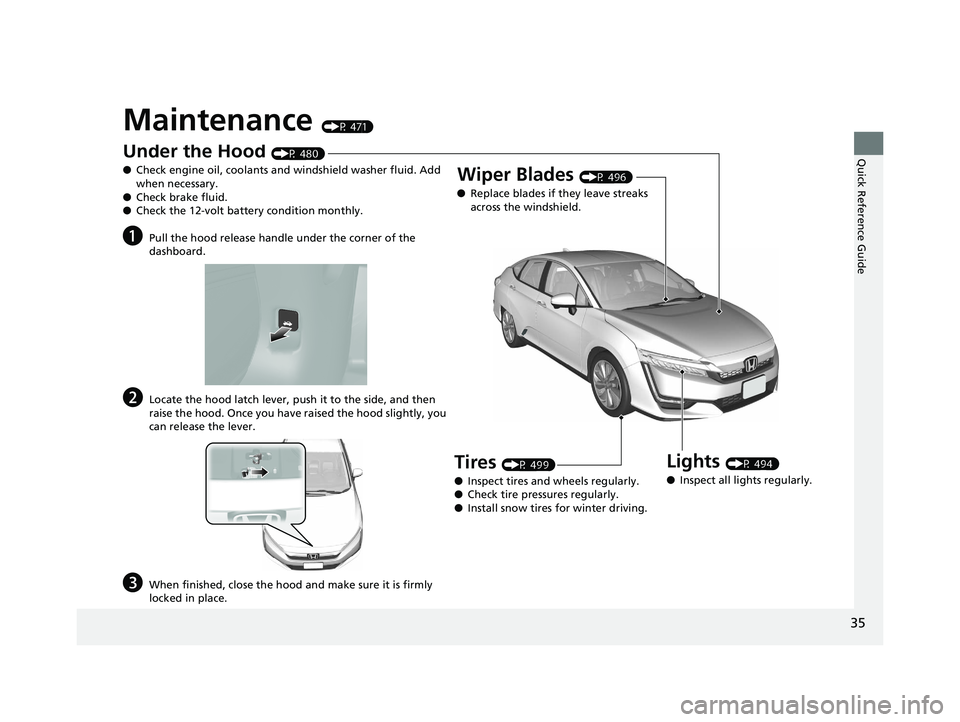
35
Quick Reference Guide
Maintenance (P 471)
Under the Hood (P 480)
● Check engine oil, coolants and windshield washer fluid. Add
when necessary.
● Check brake fluid.
● Check the 12-volt battery condition monthly.
a Pull the hood release handle under the corner of the
dashboard.
b Locate the hood latch lever, push it to the side, and then
raise the hood. Once you have raised the hood slightly, you
can release the lever.
c When finished, close the hood and make sure it is firmly
locked in place. Lights (P 494)
● Inspect all lights regularly.Wiper Blades (P 496)
● Replace blades if they leave streaks
across the windshield.
Tires (P 499)
● Inspect tires and wheels regularly.
● Check tire pressures regularly.
● Install snow tires for winter driving.18 CLARITY PHEV CSS-31TRW6000.book 35 ページ 2017年8月31日 木曜日 午後2時 49分